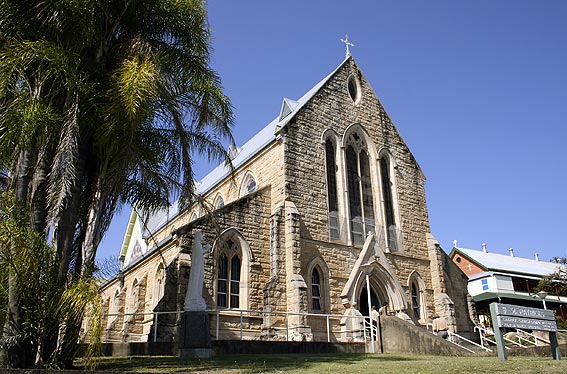
St Patrick's Catholic Church, Gympie
[Photograph by Trevor Bunning (October 2007)]

St Patrick's Catholic Church, Gympie
[Photograph by Trevor Bunning (October 2007)]
Historical and Technical Documentation by Geoffrey Cox
© OHTA 1989, 2007, 2011 (last updated March 2011)
The City of Gympie effectively started with 'The Great Australian Gold Rush' when James Nash discovered gold there in 1867. It was between this time and the mid-1920s that the town enjoyed its greatest period of prosperity on account of the diggings. It was also during this period that all four pipe organs in the town were installed – located in churches placed on hills surrounding the city: St Patrick's Catholic Church on Carlton Hill, the Presbyterian Church on Red Hill, the Wesleyan Methodist Church on Surface Hill, and the Church of England on Palatine Hill.
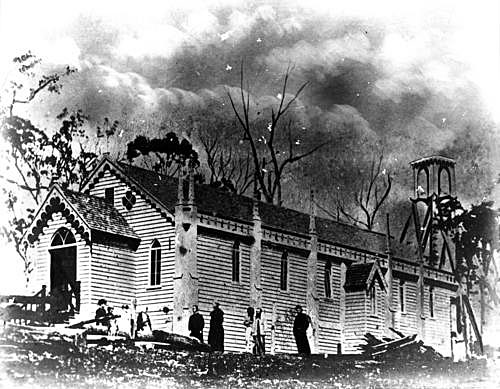
The first St Patrick's Catholic Church, Gympie, c.1870
[Photograph: John Oxley Library, State Library of Queensland]
The first Catholic Mass was celebrated in Gympie in 1868 in the Brisbane Hotel, soon after the discovery of gold in the area, and a timber church was opened on the present Carlton Hill site by the end of that year. It was replaced in 1872 by a larger hardwood church, and finally by the present substantial sandstone building, erected in 1883-87 to the design of the prominent Queensland architect, F.D.G. Stanley. The organ gallery, designed by the Gympie architect, Hugo Durietz, was added in 1896. The building was intended originally to accommodate transepts, which have never been added, although a polygonal chancel, sacristy and sanctuary were added in 1925 to the design of Brisbane architects, Cavanagh and Cavanagh.1

The builder's nameplate on the organ
[Photograph by Geoffrey Cox (October 2007)]
The nameplate on the organ records that the instrument was built by "Rich'd Heslop, 16 Burma Rd, London, N." The organ was opened and blessed at the 11 o'clock mass on 27 March 1898. The Brisbane organist, S.G. Benson played at Benediction in the evening and also gave a recital on the following Monday evening:
NEW ORGAN IN ST. PATRICK'S, GYMPIE.
An organ by Richard Heaslop, London, has just been imported and erected in St. Patrick's Church, Gympie. At the 11 o'clock mass on Sunday last, as we learn from the "Times," his Grace, Archbishop Dunne, blessed the instrument, and congratulated the congregation on possessing one of the finest pipe organs of any Roman Catholic Church within his diocese. At the evening service Mr. S. G. Benson, of Brisbane, manipulated the instrument, and also had the choir, who acquitted themselves in a manner worthy of the occasion, completely under his charge. Those present were treated to some of the finest Church music ever heard on Gympie. His Grace the Archbishop also made a short address during the service. The organ consists of two complete manuals and full composite [sic.] pedals: the small [sic.] organ contains six stops and the great 5, with an independent bass stop, or Bourdon, as it is technically called, on the pedals. The solo stops throughout are exceptionally sweet and brilliant, and the flute stop, in the great organ, is much like the instrument it represents. A great feature of the small organ is the exquisite vox angelica. The general effect of the instrument is highly satisfactory, especially for its dimensions, and the tone is unmistakably sweet. According to those best able to judge, it exactly suits the church in which it is likely to prove so prominent and attractive a feature in the future. Mr. Benson gave an organ recital in the church on Monday evening.2
The reference to six stops in the Swell , including the Vox Angelica, may be an error, as there appear always to have been seven stops in the Swell. It is possible that one Swell stop may have been added later, but the only recorded addition to the organ in its entire history is a new tremulant added in August 1936 by Whitehouse Bros of Brisbane.3
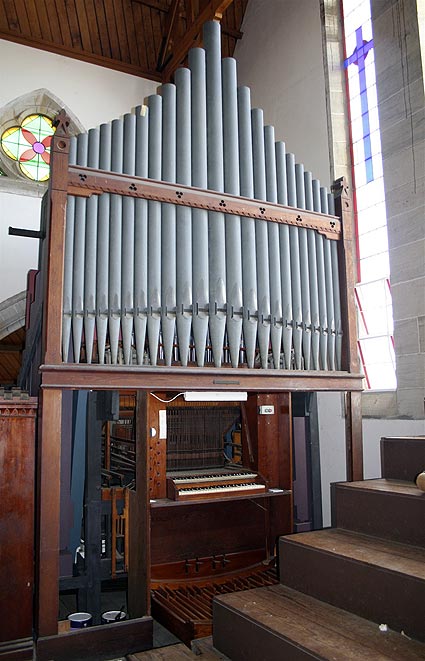
[Photograph by Trevor Bunning (October 2007)]
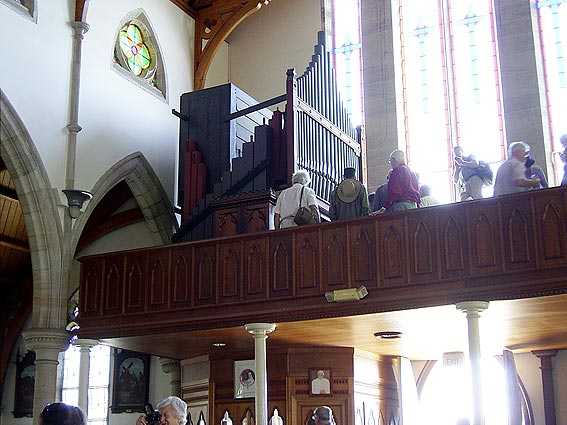
[Photograph by Mark Quamby (October 2007)]
The organ is located in the elevated west gallery of this pleasantly reverberant church. The ivories on the keyboards are tropic-pinned, as is the case in several other organs built for the Queensland climate. Before 2008, the instrument faced sideways across the gallery. The façade pipes have never been stencilled. The organ remains in substantially original condition, and the pipework is still cone-tuned.

The console of the Heslop organ
[Photograph by Howard Baker (October 1989)]

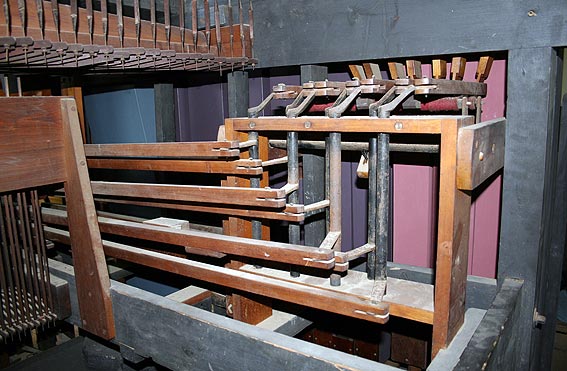

Original key- and stop-action action preserved intact
[Photographs by Trevor Bunning (October 2007)]
An appeal to raise money for the restoration of the instrument was announced in 1991.4 The restoration was carried out in stages by W.J. Simon Pierce of Brisbane: the main soundboards and pipework in 1993, the bellows and blower in 2000,5 and the manual action and keyboards in 2007-08. The façade pipes retained their original finish until 2008, when the entire instrument was turned 90 degrees to face down the nave.6
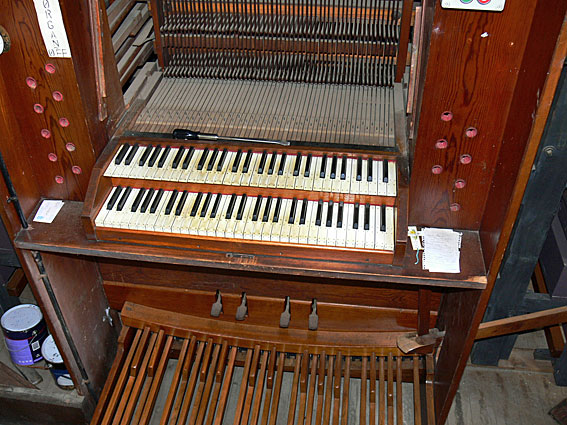
The console during the restoration of 2007-08, showing the
original tropic-pinned ivories, key action and trigger swell lever
[Photograph by John Maidment (October 2007)]
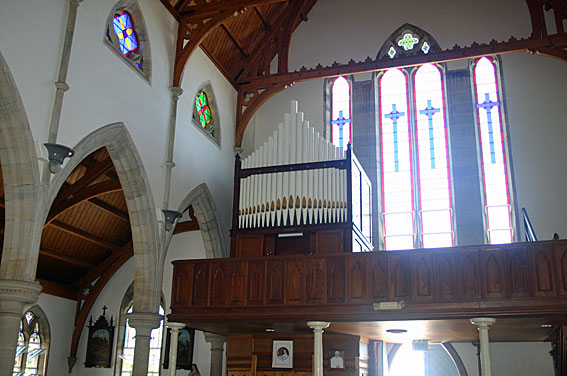
The entire organ turned to face down the nave
[Photograph by Simon Pierce (2008)]
| GREAT Open Diapason Dulciana Flute Principal Fifteenth SWELL Violin Diapason Lieblich Gedackt Gamba Vox Celeste Gemshorn Fifteenth Oboe PEDAL Bourdon COUPLERS Swell to Great Swell to Pedals Great to Pedals |
8 8 8 4 2 8 8 8 8 4 2 8 16 |
[gvd bass] [open] [gvd bass] [Tenor C] |
Swell tremulant [1936]
Drawstop console, with tropic-pinned ivories
2 combination pedals to Great Organ
2 combination pedals to Swell Organ
Compass: 56/30
Trigger swell lever
Pedalboard: concave and straight
Mechanical action.7
__________________________________________________________________________
1 Queensland Heritage Council, Queensland Heritage Register, location 601503.
2 The Brisbane Courier (30 March 1898), p. 5.
3 Whitehouse Bros Ledger (1922-1940), p. 39.
4 OHTA News, vol. 15, no. 2 (April 1991), p. 6.
5 Personal communication to G. Cox from W.J. Simon Pierce, January 2003.
6 OHTA News, vol. 32, no. 3 (July 2008), pp. 9-10.
7 Specification noted by G. Cox, 1974 and 1989.


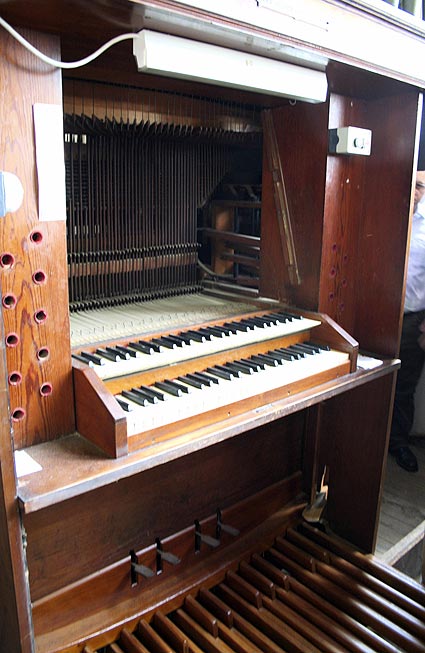
[Photographs by Trevor Bunning (October 2007)]